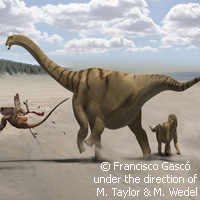'Alive and kicking' in the Early Cretaceous
Fossilised bones found in a quarry in the US state of Utah have turned out to be those of an unknown species of sauropod, new UK-US research shows. A description of the newly discovered genus is published in the journal Acta Palaeontologica Polonica. The new dino's defining feature? A truly memorable pair of (hind]) legs. Scientists from the UK and US were involved in the classification of this newcomer from the distant past. Analysing the bones, which are presumed to be those of an adult and a juvenile specimen, the researchers were intrigued by the unusual shape of the hipbone. In the new species, this is substantially bigger than that of similar dinosaurs and provides a much larger area for the attachment of muscles. With hipbones such as these, the animal would probably have had the largest leg muscles of any dinosaur in the sauropod family, the group of long-necked, long-tailed quadrupeds that notably includes the largest creatures ever to walk the earth. Named for its spectacular limbs and in honour of renowned avocational palaeontologist John 'Jack' McIntosh, Professor of Physics Emeritus at the Wesleyan University in Connecticut (US), Brontomerus mcintoshi is known to friends as 'thunder thighs'. 'Brontomerus mcintoshi is a charismatic dinosaur and an exciting discovery for us,' says first author Mike Taylor from University College London (UK). While the animal's powerful hindquarters may steal the show, its other features are just as impressive. The larger of the two specimens would have weighed in at 6 tonnes and measured 14 metres (m) top to tail. Nor would the smaller specimen, with an estimated weight of 200 kilogrammes (kg) and a length of 4.5 m, have made a manageable pet. Brontomerus lived 110 million years ago, during the Early Cretaceous, and may have used its strongest feature as a weapon against contemporary predators such as Deinonychus and Utahraptor. 'When we recognised the weird shape of the hip,' says Dr Taylor, 'we wondered what its significance might be, but we concluded that kicking was the most likely. The kick would probably have been used when two males fought over a female, but given that the mechanics were all in place it would be bizarre if it wasn't also used in predator defence.' 'The shoulder blade of Brontomerus has unusual bumps that probably mark the boundaries of muscle attachments, suggesting that Brontomerus had powerful forelimb muscles as well,' adds Matt Wedel from the Western University of Health Sciences in California (US), one of the co-authors. 'It's possible that Brontomerus mcintoshi was more athletic than most other sauropods. It is well established that far from being swamp-bound hippo-like animals, sauropods preferred drier, upland areas; so perhaps Brontomerus lived in rough, hilly terrain and the powerful leg muscles were a sort of dinosaur four-wheel drive.' Insights into the life and times of Brontomerus also contribute to our knowledge of the sauropods in general. 'Because sauropods were the most abundant dinosaurs found during the Jurassic period and the rarest during the Early Cretaceous, there's long been the perception that sauropods were successful in the Jurassic and were replaced by duckbills and horned dinosaurs in the Cretaceous,' Dr Wedel notes. 'In the past 20 years, however, we are finding more sauropods from the Early Cretaceous period, and the picture is changing,' he adds. 'It now seems that sauropods may have been every bit as diverse as they were during the Jurassic, but much less abundant and so much less likely to be found.'For more information, please visit:University College London (UCL):http://www.ucl.ac.ukActa Palaeontologica Polonica:http://www.app.pan.pl/article/item/app20100073.html
Countries
United Kingdom, United States



